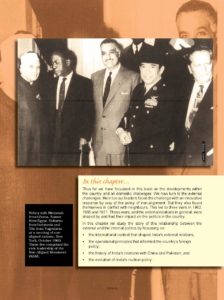#Fight with Covid_19
Nehru’s Role
- Nehru exercised foreign policy from 1946 to 1964. The three major objectives of Nehru’s foreign policy were to preserve the hard-earned sovereignty, protect territorial integrity and promote rapid economic development.
- Despite the fact that many leaders from India, wanted India to follow a pro-US foreign policy; Nehru wished to achieve his objectives of foreign policy through the strategy of non-alignment.
Distance From Two Camps
- India wanted to keep away from the military alliances led by US and Soviet Union against each other. The US was not happy about India’s independent initiatives the policy of non-alignment.
- During 1950s India took an independent stand on various international issues and could get aid and assistance from members of both power blocs.
- India’s independent stand and her growing relations with USSR hurt the sentiments of USA. Therefore, there was a considerable unease in Indo-US relations during 1950s.
Afro-Asian Unity
- Nehru era marked the establishment of contacts between India and other newly independent states in Asia and Africa.
- Under the leadership of Nehru, India convened the Asian Relations Conference in March 1947.
- India supported the process of decolonisation and opposed racism, especially apartheid in South Africa.
- The Afro-Asian Conference held in the Indonesian city of Bandung in 1955 which is known as Bandung Conference and marked the establishment of the NAM.
- The first summit of the NAM was held in Belgrade in September 1961.
Peace and Conflict with China
- Independent India began its relationship with China on a friendly note as India was one of the first countries to recognise the communist government.
- Some of Nehru’s colleagues like Vallabhbhai Patel, were worried about possible Chinese aggression in future but Nehru thought it was exceedingly unlikely that India will face an attack from China.
Paonchsheel (The five principles of peaceful co-existence) Agreement signed between Indian Prime Minister Nehru and the Chinese Premier Zhou Enlai on 29th April, 1954 was a step in the direction of stronger relationship between two.

Two Aspects to be Supported:
1. India always maintained her dignity and image of a peace loving country by taking initiatives to bring about equality and understanding among the nations i.e. India supported to end Korean War in 1953, French rule in China, US role in Vietnam.
2. India’s initiatives for Non¬alignment are also appreciable for the maintenance of mutual understanding and security. During post cold war era also, NAM had become an effective tool to make the Security Council more effective and democratic.
Two Aspects to be Changed:
1. In the course of decade of 1962-72, India faced three wars and its peaceful image played a very limited role.
2. Conflict with neighbouring countries like China and Pakistan derailed India’s concept of regional co¬operation under SAARC.
Hence, India must adopt diplomatic and defensive postures in its foreign policy to maintain its independent entity.

Wars and Peace with Pakistan
- The conflict started with Pakistan just after independence over the dispute on Kashmir.
- The India-Pakistan Indus Waters Treaty was signed by Nehru and General Ayub Khan in 1960 which has worked well despite all ups and downs in the Indo-Pak relations.
- In April 1965, Pakistan launched armed attacks in the Rann of Kutch area of Gujarat which was followed by a bigger offensive in Jammu and Kashmir in August-September.
- The hostilities came to an end with the UN intervention. Indian Prime Minister Lai Bahadur Shastri and Pakistan’s General Ayub Khan signed the Tashkent Agreement, brokered by the Soviet Union, in January 1966.
Bangladesh War, 1971
- In a dramatic internal politics during 1970 the East and West Pakistani rulers were not willing to accept the democratic verdict.
- Throughout 1971, India had to bear the burden of about 80 lakh refugees who moved to East Pakistan and took shelter in the neighbouring areas in India.
- After months of diplomatic tension and military build-up, a full-scale war between India and Pakistan broke out in December 1971.
- On 3rd July, 1972 the Shimla Agreement was singned between Indira Gandhi and Zulfikar Ali Bhutto.
1. Immediately after independence, India faced the twin challenges of Welfare and democracy. Moreover, India started participating in the world affairs as an independent nation state with the overall context like the legacy of many international disputes left by the British, pressures created by partition and poverty alleviation.
2. India was born in the backdrop of world war, hence it decided to conduct foreign relations with an aim to respect the sovereignty of other nations to achieve security through maintenance of peace. For this, India laid down directive Principles of State Policy in the Article 51 of Indian Constitution.
3. The foreign policy of a nation is the interplay of domestic and external factors. Pt. J.L. Nehru was the ‘Chief Architect of India’s Foreign Policy’ with the objectives of preserving sovereignty of India, protection of territorial integrity and promotion of rapid economic development. Hence India adopted NAM to stay away from any military blocs.
4. Nehru’s Era established the contacts between India and States in Asia and Africa by convening conferences on Asian Relations (March 1947), Indonesia’s Freedom Struggle (1949), decolonisation process, and engaged herself in Bandung Conference in 1955 .with the newly independent Asian and African Nations.
5. Panchsheel, the five principles of peaceful co-existance (29 April 1954) between India and China was a stronger step towards friendship and relations. India advocated China’s new government as a communist even in the UN after Chinese revolution in 1949 to ahead a friendly step.
6. India and China began to conflict on annexation of Tibet by China and suppressed Tibetan culture also. China claimed Aksai Chin area and NEFA within the Indian territory, which differences could not be resolved despite correspondence and discussions and led India to indulge in conflict.